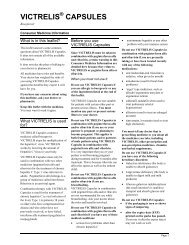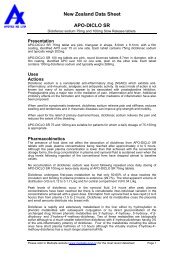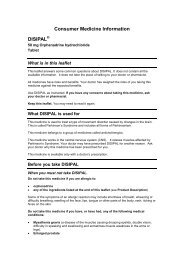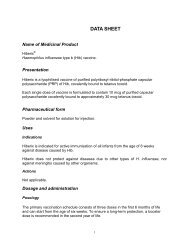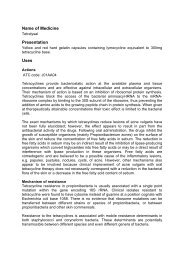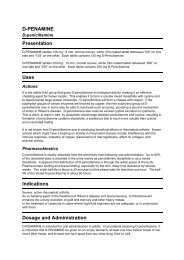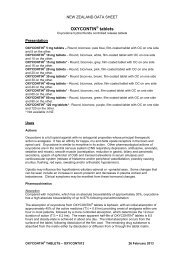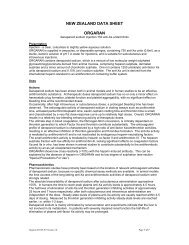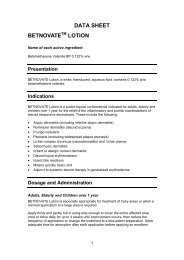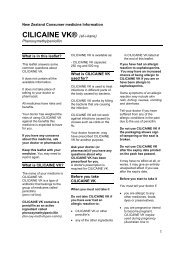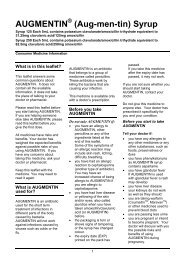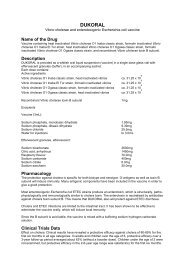New Zealand Datasheet Name of Medicine NovoRapid - Medsafe
New Zealand Datasheet Name of Medicine NovoRapid - Medsafe
New Zealand Datasheet Name of Medicine NovoRapid - Medsafe
You also want an ePaper? Increase the reach of your titles
YUMPU automatically turns print PDFs into web optimized ePapers that Google loves.
Change-from-baseline values <strong>of</strong> HbAlc, blood glucose variability, average daily insulin use or<br />
body weight were not significantly different between treatment groups at any time point. The<br />
adverse event pr<strong>of</strong>ile <strong>of</strong> <strong>NovoRapid</strong> was similar to that <strong>of</strong> buffered regular insulin and insulin<br />
lispro, and the three treatment groups had similar rates <strong>of</strong> hypoglycaemia. When<br />
administered as continuous subcutaneous insulin infusion in a pump, <strong>NovoRapid</strong> was shown<br />
to be as safe and effective as buffered regular human insulin.<br />
ANA/DCD/066<br />
This phase IIIb, double-blind, randomized, cross-over, multi-centre trial compared the<br />
frequency <strong>of</strong> major hypoglycaemic episodes after 16 weeks treatment with <strong>NovoRapid</strong><br />
versus 16 weeks treatment with soluble human insulin in 139 adults with well-controlled type<br />
1 diabetes treated on a basal bolus regimen. Frequency <strong>of</strong> major hypoglycaemic episodes<br />
during the treatment periods was the primary endpoint.<br />
A statistically non-significant (p=0.119) <strong>NovoRapid</strong>/soluble human insulin relative risk for<br />
major hypoglycaemia <strong>of</strong> 0.72 (95% CI: 0.47-1.09) was found. A secondary finding was that<br />
subjects treated with <strong>NovoRapid</strong> experienced a significantly (p=0.001) lower rate <strong>of</strong> major<br />
hypoglycaemic episodes during the night (midnight-6am). The estimated <strong>NovoRapid</strong>/soluble<br />
human insulin relative risk was 0.28 (95% CI: 0.13-0.59). This was not a predefined endpoint<br />
in the study protocol and this result represents a post hoc analysis. A statistically significant<br />
(p=0.048) reduction in the frequency <strong>of</strong> minor hypoglycaemic episodes was found with<br />
<strong>NovoRapid</strong> treatment (N=1590) compared to human soluble insulin (N=1752), with the<br />
estimated <strong>NovoRapid</strong>/soluble human insulin relative risk being 0.93 (95% CI: 0.87-1.00). No<br />
significant differences between insulin aspart and human soluble insulin were found for the<br />
investigated glycaemic control parameters or in the domain scores <strong>of</strong> the Quality <strong>of</strong> Life<br />
questionnaires. The statistical testing was not adjusted for the multiple variables examined.<br />
028/UK<br />
This phase II trial was conducted in 16 subjects with well controlled type 1 diabetes who did<br />
not require intravenous therapy. Both <strong>NovoRapid</strong> and human soluble insulin were given<br />
intravenously to determine the blood glucose threshold for autonomic activation during<br />
hypoglycaemia. There were no statistically significant differences between <strong>NovoRapid</strong> and<br />
soluble human insulin. No advantage is expected in giving <strong>NovoRapid</strong> intravenously over<br />
soluble human insulin intravenously.<br />
ANA-1415<br />
A clinical trial investigated the safety and efficacy <strong>of</strong> insulin aspart (N = 26) vs. soluble<br />
human insulin (N = 26) in children with type 1 diabetes aged 2 – 6 years. Human NPH<br />
insulin was used as the basal insulin in both groups. Similar results for the two primary<br />
safety and efficacy endpoints (frequency <strong>of</strong> hypoglycaemic episodes and postprandial<br />
glucose increment, respectively), as well as the secondary endpoints, were observed with<br />
both regimens.<br />
ANA-1474 and -2067<br />
A clinical trial comparing safety and efficacy <strong>of</strong> insulin aspart vs. soluble human insulin in the<br />
treatment <strong>of</strong> pregnant women with type 1 diabetes (322 exposed pregnancies: insulin aspart,<br />
N = 157; human insulin, N = 165) did not detect any adverse effect <strong>of</strong> insulin aspart on<br />
pregnancy or on the health <strong>of</strong> the foetus/newborn. Efficacy when measured by HbA1c was<br />
observed to be comparable to insulin aspart versus soluble human insulin, whilst mean<br />
prandial glucose increments were significantly improved for insulin aspart during the first and<br />
third trimesters. In addition the data from a clinical trial including 27 women with gestational<br />
diabetes randomised to treatment with insulin aspart vs. soluble human insulin (insulin<br />
aspart, N = 14; human insulin, N = 13) showed similar safety pr<strong>of</strong>iles between treatments.<br />
12



